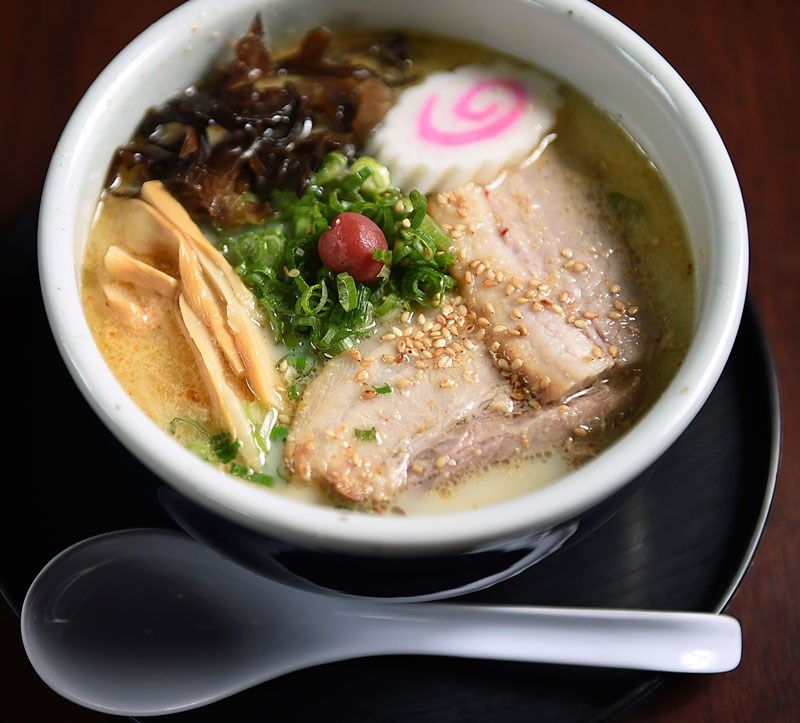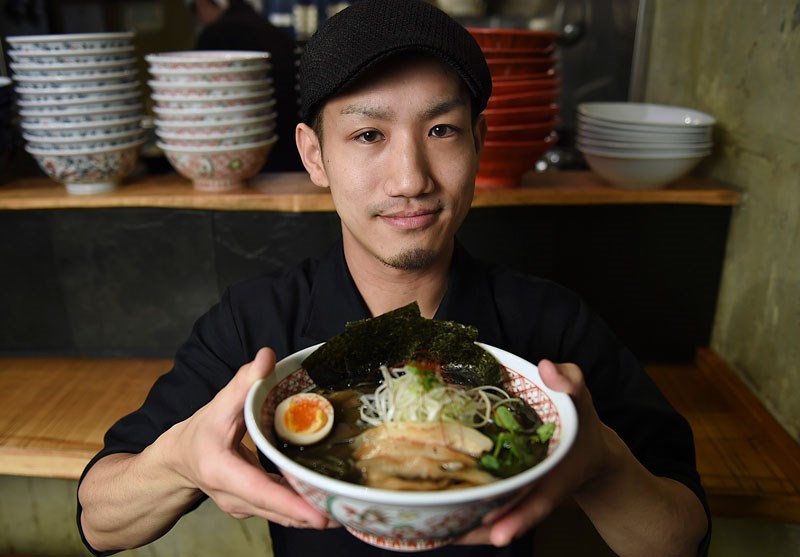Barak Kushner, a professor of Japanese history at the University of Cambridge, writes in his book, Slurp! A Social and Culinary History of Ramen, that “cultural identity is tied inextricably to the tradition of cooking, eating and producing food.”
It makes perfect sense, then, why a bowl of Jewish penicillin (AKA soup) with chicken feet constitutes “comfort” in my family.
In Japan, ramen has, surprisingly, come to be an integral part of the national cultural identity. Why surprising? Because it originated in China.
In his book, Kushner explores Japan’s long, complex and often fraught history with China, but the salient points are as follows. The word “ramen” is based on the Japanese pronunciation of the Chinese word lamian. In fact, in the early 20th century, this dish was often referred to as “Chinese soba.” It wasn’t until the 1950s that the modern term became the standard. In this post-WWII era, the proliferation of the simple noodle soup was found at street carts and in restaurants all over the country in its original version: a salt-and-pork-bone broth housing a handful of thin, cut noodles and minimal toppings.
Then, in 1958, Momofuku Ande, the founder of Nissan Foods, invented instant ramen and the world was never the same. Over the next few decades, global knowledge of and appreciation for ramen exploded. Regional iterations developed and, by the early 1980s, a cultural icon was born. No surprise, then, that Vancouver’s ramen scene is a fairly recent occurrence. It’s really only been in the last two decades that ramen has taken a hold in this city, mainly centered around the western end of Robson Street, in what has come to be known as Ramen Row.
Perhaps it was the original settlement of international students in the area, or the cheap rents that originally made this end of Vancouver’s high-density shopping district such an ideal neighbourhood for the Japanese and Korean mom-and-pop shops that originally sprouted there. Whatever the reason, the concentration of Japanese noodle shops on and around this street have become a destination for the entire Lower Mainland.
But what, exactly, is ramen? The answer depends on which region you’re referencing and who you ask. The two key components are the broth and the noodles. While tonkotsu (pork-based broth) is most popular, broths based on chicken, seafood or vegetables also have sizeable followings; the broth may be seasoned with salt, soy, miso or even curry. As for the noodles, the typical ramen noodle is made from wheat flour, salt, water and kansui, a type of alkaline water high in mineral content, sodium carbonate and potassium carbonate. Kansui is what gives ramen noodles their firmer texture and distinctive taste. Toppings typically include chasu (slow-cooked slices of fatty pork), seasoned soft-boiled egg, and green onion, among others.
On Ramen Row, almost every region and style is represented. At Marutama (780 Bidwell), which opened just over three years ago, the ramen is based on a creamy, rich chicken broth that glistens with small globules of fat on its surface. The ramen bowls here are a little more expensive than most ($14-$18), but this is understandable since they make their own noodles (which isn’t the norm). The broth is also something special. Made using chicken feet (whoot!), bones and gizzards, it’s full of umami, yet doesn’t leave the heavy, oily finish on the palate that some pork-based broths can deliver. The use of aosa seaweed and scallion completes the bowl. You can order it spicy or mild: I recommend the latter. This allows you to fully appreciate the deep flavour of the broth, and add the optional (and excellent) fried garlic chips that sit on every table. No soy needed, thanks to the briny saltiness of the seaweed. The chasu is excellent, but the soy egg is the real star of the show here, with its lightly seasoned exterior and runny orange yolk. Order your noodles firm, medium or soft, and get ready to slurp with abandon.

At the busy Hokkaido Ramen Santouka (1690 Robson), the line-ups start early and run late. In operation in Vancouver for about seven years now, the hype shows no signs of slowing for this global chain. All of the broths here (simmered on average for at least 20 hours) are pork-based and can be ordered as shoyu (soy), shio (salt), miso or spicy miso. The prices are slightly lower than at Marutama, and the portions can be massive enough for sharing. No seaweed here, but do expect pickled plum, bamboo shoots, jelly-ear and/or green onion along with your roasted pork. Spend a couple extra bucks to get the pork cheek – slow-cooked to ravishing perfection.
At Kintaro (788 Denman, no website), pork and chicken broth is simmered for more than 22 hours to achieve the dense, creamy texture that has made this relative old-timer (open since 1999) a consistent crowd-pleaser. The added pork fat (available in light, medium and rich) makes the broth a lush experience on its own – and that’s before you throw in the barbecued pork (also available in lean or fatty versions). Kintaro’s sister restaurant, Motomachi Shokudo (740 Denman, no website), offers a more refined and delicate broth: chicken-based and definitely healthier than the slightly oily affairs at Kintaro. The soft-boiled eggs are organic, the broth is more clear than Marutama’s, and the noodles are slightly thicker, with a bit more chew. What you really want to try here, though, is the bamboo-charcoal dark miso ramen that sees powdered bamboo charcoal blended into the broth for a deep, dark and thick experience that is nicely offset by pickled bamboo, barbecued pork, green onion and, of course, the runny soy egg.
At the other end of Robson, Jinya Ramen Bar (270 Robson) serves up what is likely the city’s darkest broth: the black ramen, made with charred garlic oil that imparts deep colour and intense garlic flavour. The chicken- and vegetable-based broths here are lighter than most, but the black version is a strong taste that may take some getting used to.
Regardless of where you go a-slurping, you’re pretty much guaranteed a delicious experience that will warm your heart and fill your stomach in equal measure.
More places to try ramen
While Robson and Denman seem to have a lock on the ramen scene, there are a few places further afield that deliver rather stunning bowls of noodle goodness.
Harvest Community Foods
Andrea Carlson, chef and owner of Burdock & Co., runs this little café/grocery with quite the panache, and dishes out a super-fantastic bowl of porky, eggy noodles as well. (243 Union)
Ramen Gojiro
Close to the financial district, this relative newcomer serves up a rich, bold broth made from pork head and bones as well as chicken, and is loaded with massive amounts of noodles and toppings. “More is more” seems to be the mantra here. (501 Dunsmuir)
Gyoza Bar
Despite the name, ramen is a key focus here, especially the kaisen tomato version that is oddly reminiscent of French bouillabaisse. Loaded with seafood and chicken chasu, it’s an elevated dish that delivers a different yet tasty experience. (622 W. Pender)



